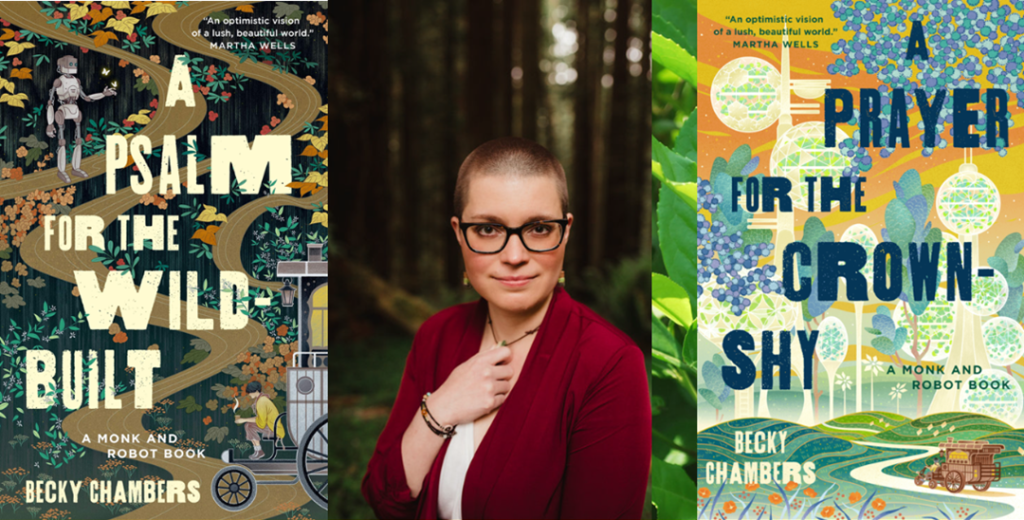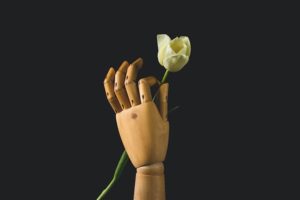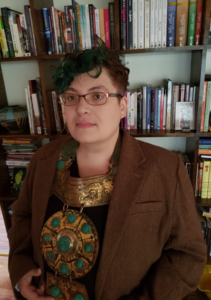
“This story would be enjoyed, I think, by travelers, gardeners, utopianists, urban planners, makers of good meals, sociologists, and people who visualize strongly when they read.”
I have yet to entirely sort my emotional sensibilities about Becky Chambers’ recent Monk and Robot novella diptych. They are themselves works about sorting so perhaps that is fitting. The first is titled A Psalm for the Wild-Built, the second A Prayer for the Crown-Shy. [1] [2]
While there is an organic quality to the pair—Prayer needs Psalm to work—each book contains its own small narrative necessities. And there is a gentleness to them. Not surprisingly, then, Chambers’ books have been described by some as hopepunk. Hopepunk is a “subgenre that has emerged … which finds its narrative motivation in the idea of optimism—embodied in acts of love, kindness, and respect for one another—as resistance.” (From Merriam-Webster) [3]
THE STORY
First, the story overviews from Chambers’ website:
A Psalm for the Wild-Built
It’s been centuries since the robots of Panga gained self-awareness and laid down their tools; centuries since they wandered, en masse, into the wilderness, never to be seen again; centuries since they faded into myth and urban legend. One day, the life of a tea monk is upended by the arrival of a robot, there to honor the old promise of checking in. The robot cannot go back until the question of “what do people need?” is answered. But the answer to that question depends on who you ask, and how. They’re going to need to ask it a lot. [4]
A Prayer for the Crown-Shy
After touring the rural areas of Panga, Sibling Dex (a tea monk of some renown) and Mosscap (a robot sent on a quest to determine what humanity really needs) turn their attention to the villages of the little moon they call home. They hope to find the answers they seek, while making new friends, learning new concepts, and experiencing the entropic nature of the universe. [5]
THE TELLING
From a writerly perspective, Chambers does some interesting things. The first book is straightforward narrative, a chronology of events, where we see a young person by name of Sibling Dex make a decision to change their life doings then, as we watch that happen, we are introduced to the intricacy of Panga’s one main urban locale, The City, and the post-Transition, rewilded beauty of the land and villages away from this urban center.
When Dex meets a stranger named Splendid Speckled Mosscap a sort of confrontation ensues, not between Dex and Mosscap but between the assignments each have set for themselves. Life-altering assignments they are but now, with an unexpected companion, they must make other decisions, ones they had not anticipated.
The second book begins with the same episodic structure but the scenes are more freestanding. Dex and Mosscap are still traveling together, the point of it to explore a question Panga’s robot denizens have about the human denizens. There are stop-offs. They explore. They meet people, make and receive delicious meals, engage in a little on-page flirting and off-page sex, and struggle though some good conversations. But in the course of these single adventures the sociology and philosophy of this splendidly crafted place Chambers has invented become the focus. It’s not that the plot loses its way—it doesn’t—it just doesn’t seem or want to matter as much.
HARD SCIENCE SOFTLY, softly

From the perspective of world crafting or world building, Chambers is utterly first rate. Old-timey science fictioneers believe the science has to be hard, that is, “characterized by concern for scientific accuracy and logic” and usually a lot of machinery. [6] The science grounding here is indeed hard but framed within the context of long time passing.
Writing about Book 1, NPR’s Amal El-Mohtar describes that time: “Centuries ago, robots woke to sentience and went on strike, and the humans who made them as laboring tools decided to respect their newfound agency and release them. The robots chose to vanish into the wilderness in order to learn about a world beyond the bounds of human design.” [7]
Psalm shows us the humans’ world, much of it rewilded, its culture intensely social, interpersonally aware, and technologically kind. When a robot named after a mushroom enters, the solitary young human, a tea monk of whom we have become fond, finds themselves pushed to sort further beyond what they don’t perhaps realize is their unsorted complacency.
By the time we are well into Book 2 the nature of hard science has softened. Mosscap faces an existential dilemma: should it adhere to the robot’s technological theology that sees mechanical breakdown as inevitable and part of the natural evolution where new robots are reproduced from the parts of the old. Dex, meanwhile, struggles with the positivist notion that one must responsibly progress when their companion’s present tense philosophy suggests simply being is sufficient.
CONNECTIONS BELOVED



The language I’ve used in the previous section makes Chamber’s storytelling sound rigid and analytical. It is not that at all. If anything, the writing and the telling, in addition to being lush and richly descriptive, are almost tender.
I’ve seen her work referred to as “comfort reading.” Certainly comfort can be taken—I could see her as a tea monk mostly easily—but it’s her optimism that gives ease and provides solace.
In that way she is very much in the storytelling tradition of Ursula K. Le Guin (L), Ann Leckie (C), and R.B. Lemberg (R). [8] Her style of telling is unique but one hears echoes.
Nasrullah Mambrol captures the core of Le Guin’s work:
“When Ursula K. Le Guin . . . has Geny Ai state in The Left Hand of Darkness that ‘truth is a matter of the imagination,’ she is indirectly summarizing the essential focus of her fiction: explorations of the ambiguous nature of truth through imaginative means. Few other contemporary authors have described this process with the force and clarity of Le Guin. Her subject is always humankind and, by extension, the human environment, since humanity cannot survive in a vacuum; her technique is descriptive, and her mode is metaphoric. The worlds Le Guin creates are authentic in a profoundly moral sense as her characters come to experience truth in falsehood, return in separation, unity in variety.” [9]
In assessing Leckie’s Ancillary Trilogy Liz Borke captures the author’s gist:
“Ann Leckie’s Imperial Radch books—the trilogy which comprises Ancillary Justice, Ancillary Sword, and Ancillary Mercy—have a significant amount of thematic depth. On the surface, this trilogy offers fairly straightforward space opera adventure: but underneath are a set of nested, interlocking conversations about justice and empire, identity and complicity. How one sees oneself versus how one is seen by others: when is a person a tool and when is a tool a person? The trilogy is one long argument on negotiating personhood and the appropriate uses of power; on civilisation and the other; and on who gets to draw which lines, and how.” [10]
American science fiction editor, and critic Gary K. Wolfe, says this about Lemberg’s The Four Profound Weaves:
“…it’s apparent from the outset that their novel is the work of a poet. The prose is lyrical, evocative, and precise, and it soars when it needs to, without ever yielding to coloratura dramatics. That’s not the only thing appealing, and even refreshing, about this remarkable novel. For one thing, Lemberg demonstrates how it’s possible to construct an evocative and expansive setting without the need for hundreds of pages of arduous, stone-by-stone worldbuilding, and how, by doing this, the setting becomes a function of the tale, rather than the other way around.” [11]
What Chambers shares with these authors is power of vision, intense storytelling art, and a stunningly deep heart and love of person-, plant-, and animal-kind. She, like them, pours all three into her writing. The style of each is singularly theirs: Le Guin, intelligent and muscularly crafted; Leckie, complex and psychologically confident; Lemberg, lyrical and spare; and Chambers, detailed, playful, and easy, yet meticulously scribed.
One feels held by Chambers.
 In exploring the craft, the story, and the impact of Chambers’ Monk and Robot books, I don’t want to overlook their pure whimsy and joyfulness. Panga is a lovely little place. The trees, the riverways, the little bugs and great animals; the sheer exuberance of living things is a delight to experience, story and characters aside.
In exploring the craft, the story, and the impact of Chambers’ Monk and Robot books, I don’t want to overlook their pure whimsy and joyfulness. Panga is a lovely little place. The trees, the riverways, the little bugs and great animals; the sheer exuberance of living things is a delight to experience, story and characters aside.
One memory I will keep, and one key reason I will reread these books many times, is the food and many kinds of teas. One can see the delicious beauty, smell the mystery of combined ingredients and seasonings, and revel in the shared delight that is its making and sharing. The meals are intermittent but so worth the waiting for.
This story would be enjoyed, I think, by travelers, gardeners, utopianists, urban planners, makers of good meals, sociologists, and people who visualize strongly when they read. Reading it to children might be fun too, though the philosophizing language and concepts would need to be translated for the simpler understanding of the very young.
If you have a question or comment for me, drop me a line via my Contact page.
© J.A. Jablonski 2022. All rights reserved.
ABOUT BOOK THOUGHTS
“Book Thoughts” is an intermittent column within my blog. The essays are not so much book reviews as book responses. I like to converse with and around the books I read.
How to cite this post
Jablonski, J.A. (2022, August 16). Becky Chambers | The Monk & Robot Series. Blog post. J.A. Jablonski (website).
https://jajablonski.com/2022/08/16/becky-chambers/
IMAGE CREDITS
Header image
-
- Becky Chambers. Author photo. From her website
- Covers of A Psalm for the Wild-Built & A Prayer for the Crown Shy from Tordotcom
Wooden mannequin hand holding ivory-colored tulip. Photo by Trollinho on Unsplash
Ursula K. Le Guin. Author photo by Marian Wood Kolisch. Copyyright © by Marian Wood Kolisch
Ann Leckie. Author photo. From Leckie’s website
R.B. Lemberg. Author photo. From Lemberg’s website
Tea pot & two tea cups on wooden tray. Photo by Alisher Sharip on Unsplash
SOURCES & NOTES
Disclaimer: As a Bookshop Affiliate (US only) I will earn a commission if you click through on a book title I’ve linked to and make a purchase.
[1] Chambers, Becky. (2021). A Psalm for the Wild-Built. Tordotcom.
For a complete listing of Chambers’ books see her website, Other Scribbles.
[2] Chambers, Becky. (2021). A Prayer for the Crown-Shy. Tordotcom.
[3] Definition from Merriam-Webster. (Note: An article I did not cite from but is especially good re: hope and Becky Chambers is Kehe, Jason. (2021, Sept 16). “Is Becky Chambers the Ultimate Hope for Science Fiction?” Backchannel (column), Wired.)
[4] Description from Chambers website.
[5] Description from Chambers website.
[6] Definition from the Wikepedia entry for “Hard science fiction.”
[7] El-Mohtar, Amal. (2021, July 18). “A Monk and a Robot Meet in a Forest . . . And Talk Philosophy in the New Novel.” Book Reviews. NPR.
[8] See the websites of Ursula K. Le Guin, Ann Leckie, and R.B. Lemberg for their book info.
[9] Mambrol, Nasrullah. (2019, Jan 2). “Analysis of Ursula K. Le Guin’s Novels.” Literariness.org.
[10] Bourke, Liz. (2016, Jan 19). “The Politics of Justice: Identity and Empire in Ann Leckie’s Ancillary Trilogy.” Tor.com.
[11] Wolfe, Gary K. (2020, Sept 29). “Gary K. Wolfe Reviews The Four Profound Weaves by R.B. Lemberg.” Locus Magazine.


